Page 376 of 509
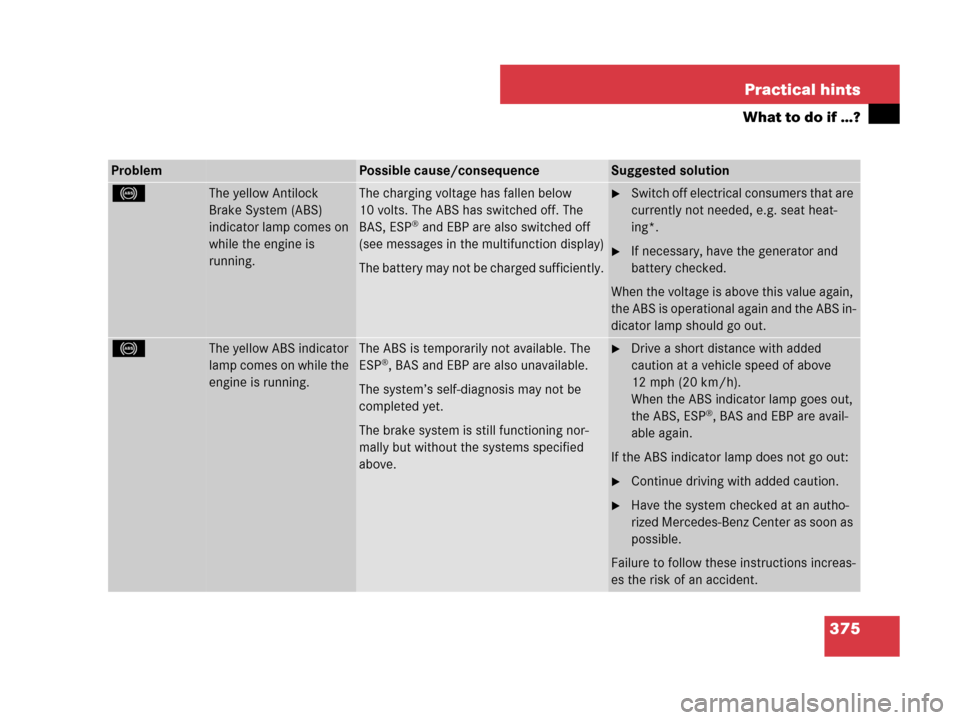
375 Practical hints
What to do if …?
ProblemPossible cause/consequenceSuggested solution
-The yellow Antilock
Brake System (ABS)
indicator lamp comes on
while the engine is
running.The charging voltage has fallen below
10 volts. The ABS has switched off. The
BAS, ESP
® and EBP are also switched off
(see messages in the multifunction display)
The battery may not be charged sufficiently.
�Switch off electrical consumers that are
currently not needed, e.g. seat heat-
ing*.
�If necessary, have the generator and
battery checked.
When the voltage is above this value again,
the ABS is operational again and the ABS in-
dicator lamp should go out.
-The yellow ABS indicator
lamp comes on while the
engine is running.The ABS is temporarily not available. The
ESP®, BAS and EBP are also unavailable.
The system’s self-diagnosis may not be
completed yet.
The brake system is still functioning nor-
mally but without the systems specified
above.
�Drive a short distance with added
caution at a vehicle speed of above
12 mph (20 km/h).
When the ABS indicator lamp goes out,
the ABS, ESP
®, BAS and EBP are avail-
able again.
If the ABS indicator lamp does not go out:
�Continue driving with added caution.
�Have the system checked at an autho-
rized Mercedes-Benz Center as soon as
possible.
Failure to follow these instructions increas-
es the risk of an accident.
Page 390 of 509

389 Practical hints
What to do if …?
Text messages
Display Possible cause/consequencePossible solution
ABS and ESP
Currently Unavailable
See Operator’s ManualABS and ESP® are not available due to a malfunction.
BAS and the hill start assist are also switched off. It
is possible that the self-diagnostics have not yet
been completed.
The brake system still functions normally.�Drive a short distance with gentle turns above a
speed of 12 mph (20 km/h).
The message disappears when ABS and ESP
®
are again available.
The ABS and ESP® were deactivated because of in-
sufficient power supply. The charging voltage has
fallen below 10 volts. BAS and the hill start assist are
also deactivated.
The brake system still functions normally but without
the ABS and ESP
® available.
When the voltage is above this value again, the ABS
and ESP® are operational again and the message in
the multifunction display should disappear.
If the message in the multifunction display does not
disappear:
�Have the generator (alternator) and the battery
checked.
ABS and ESP
Inoperative
See Operator’s ManualABS and ESP® are switched off due to a malfunction.
BAS and the hill start assist are also switched off.
The brake system still functions normally but without
the ABS and ESP
® available.
�Continue driving with added caution. Wheels
may lock during hard braking, reducing steering
capability.
�Have the system checked at an authorized
Mercedes-Benz Center as soon as possible.
Failure to follow these instructions increases the
risk of an accident.
Page 398 of 509
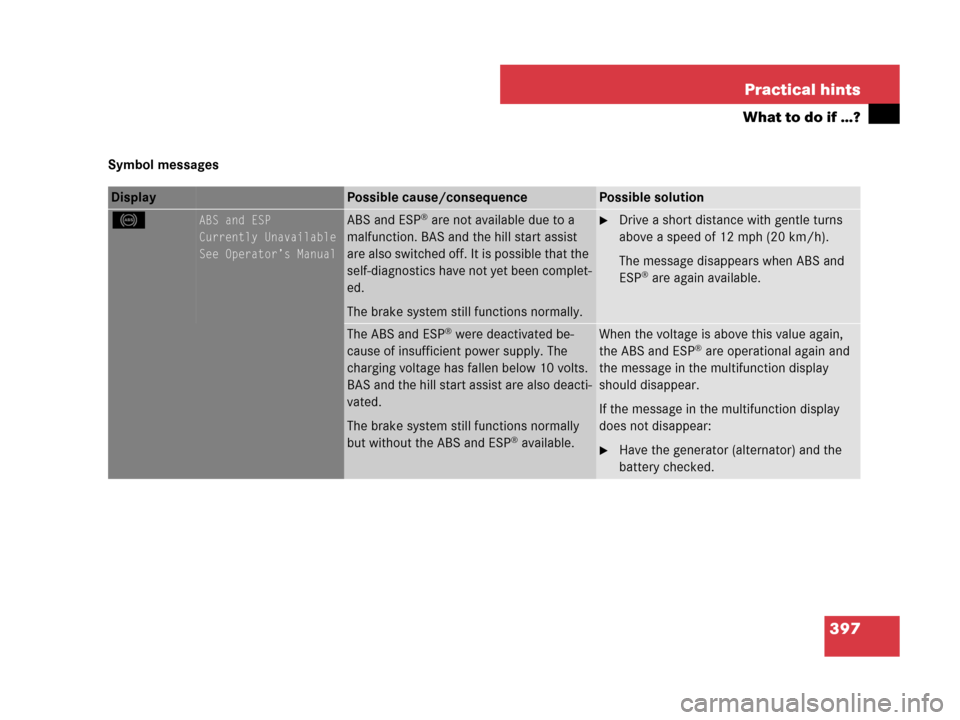
397 Practical hints
What to do if …?
Symbol messages
Display Possible cause/consequencePossible solution
-ABS and ESP
Currently Unavailable
See Operator’s ManualABS and ESP® are not available due to a
malfunction. BAS and the hill start assist
are also switched off. It is possible that the
self-diagnostics have not yet been complet-
ed.
The brake system still functions normally.�Drive a short distance with gentle turns
above a speed of 12 mph (20 km/h).
The message disappears when ABS and
ESP
® are again available.
The ABS and ESP® were deactivated be-
cause of insufficient power supply. The
charging voltage has fallen below 10 volts.
BAS and the hill start assist are also deacti-
vated.
The brake system still functions normally
but without the ABS and ESP
® available.
When the voltage is above this value again,
the ABS and ESP® are operational again and
the message in the multifunction display
should disappear.
If the message in the multifunction display
does not disappear:
�Have the generator (alternator) and the
battery checked.
Page 400 of 509
399 Practical hints
What to do if …?
Display Possible cause/consequencePossible solution
#The battery is no longer charging.
Possible causes:
�alternator malfunctioning
�broken poly-V-belt
�Stop the vehicle immediately in a safe loca-
tion and check the poly-V-belt.
If it is broken:
�Do not continue to drive. Otherwise the en-
gine will overheat due to an inoperative water
pump which may result in damage to the en-
gine.
�Notify an authorized Mercedes-Benz Center.
If it is intact:
�Drive immediately to the nearest authorized
Mercedes-Benz Center.
There is a malfunction in the electronic sys-
tem.�Have the system checked at an authorized
Mercedes-Benz Center as soon as possible.
2Check
Brake Pad WearThe brake pads have reached their wear
limit.�Have the brake pads replaced as soon as
possible.
!Brake pad thickness must be visually
checked by a qualified technician at the intervals
specified in the Maintenance Booklet.
Page 409 of 509
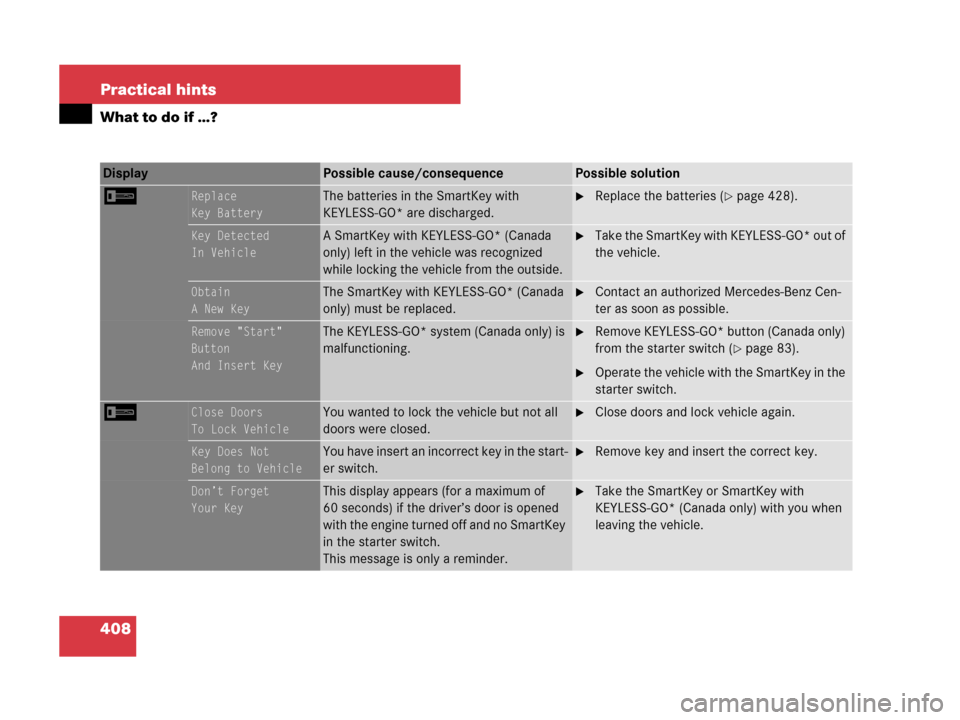
408 Practical hints
What to do if …?
Display Possible cause/consequencePossible solution
IReplace
Key BatteryThe batteries in the SmartKey with
KEYLESS-GO* are discharged.�Replace the batteries (�page 428).
Key Detected
In VehicleA SmartKey with KEYLESS-GO* (Canada
only) left in the vehicle was recognized
while locking the vehicle from the outside.�Take the SmartKey with KEYLESS-GO* out of
the vehicle.
Obtain
A New KeyThe SmartKey with KEYLESS-GO* (Canada
only) must be replaced.�Contact an authorized Mercedes-Benz Cen-
ter as soon as possible.
Remove "Start"
Button
And Insert KeyThe KEYLESS-GO* system (Canada only) is
malfunctioning.�Remove KEYLESS-GO* button (Canada only)
from the starter switch (
�page 83).
�Operate the vehicle with the SmartKey in the
starter switch.
IClose Doors
To Lock VehicleYou wanted to lock the vehicle but not all
doors were closed.�Close doors and lock vehicle again.
Key Does Not
Belong to VehicleYou have insert an incorrect key in the start-
er switch.�Remove key and insert the correct key.
Don’t Forget
Your KeyThis display appears (for a maximum of
60 seconds) if the driver’s door is opened
with the engine turned off and no SmartKey
in the starter switch.
This message is only a reminder.�Take the SmartKey or SmartKey with
KEYLESS-GO* (Canada only) with you when
leaving the vehicle.
Page 426 of 509
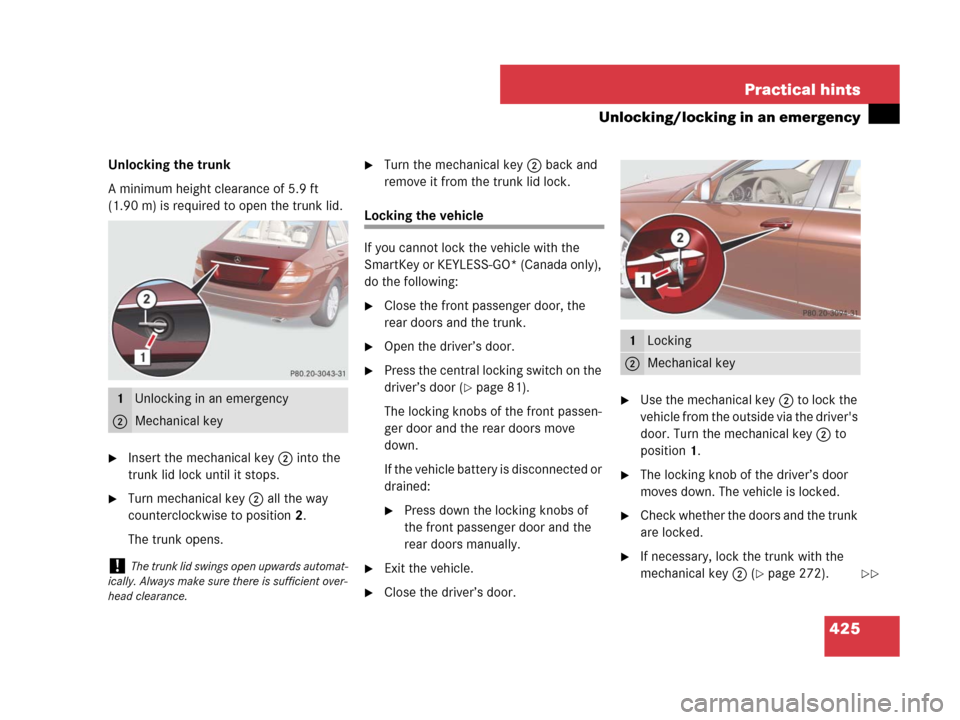
425 Practical hints
Unlocking/locking in an emergency
Unlocking the trunk
A minimum height clearance of 5.9 ft
(1.90 m) is required to open the trunk lid.
�Insert the mechanical key2 into the
trunk lid lock until it stops.
�Turn mechanical key2 all the way
counterclockwise to position 2.
The trunk opens.
�Turn the mechanical key2 back and
remove it from the trunk lid lock.
Locking the vehicle
If you cannot lock the vehicle with the
SmartKey or KEYLESS-GO* (Canada only),
do the following:
�Close the front passenger door, the
rear doors and the trunk.
�Open the driver’s door.
�Press the central locking switch on the
driver’s door (
�page 81).
The locking knobs of the front passen-
ger door and the rear doors move
down.
If the vehicle battery is disconnected or
drained:
�Press down the locking knobs of
the front passenger door and the
rear doors manually.
�Exit the vehicle.
�Close the driver’s door.
�Use the mechanical key2 to lock the
vehicle from the outside via the driver's
door. Turn the mechanical key2 to
position1.
�The locking knob of the driver’s door
moves down. The vehicle is locked.
�Check whether the doors and the trunk
are locked.
�If necessary, lock the trunk with the
mechanical key2 (
�page 272).
1Unlocking in an emergency
2Mechanical key
!The trunk lid swings open upwards automat-
ically. Always make sure there is sufficient over-
head clearance.
1Locking
2Mechanical key
��
Page 429 of 509
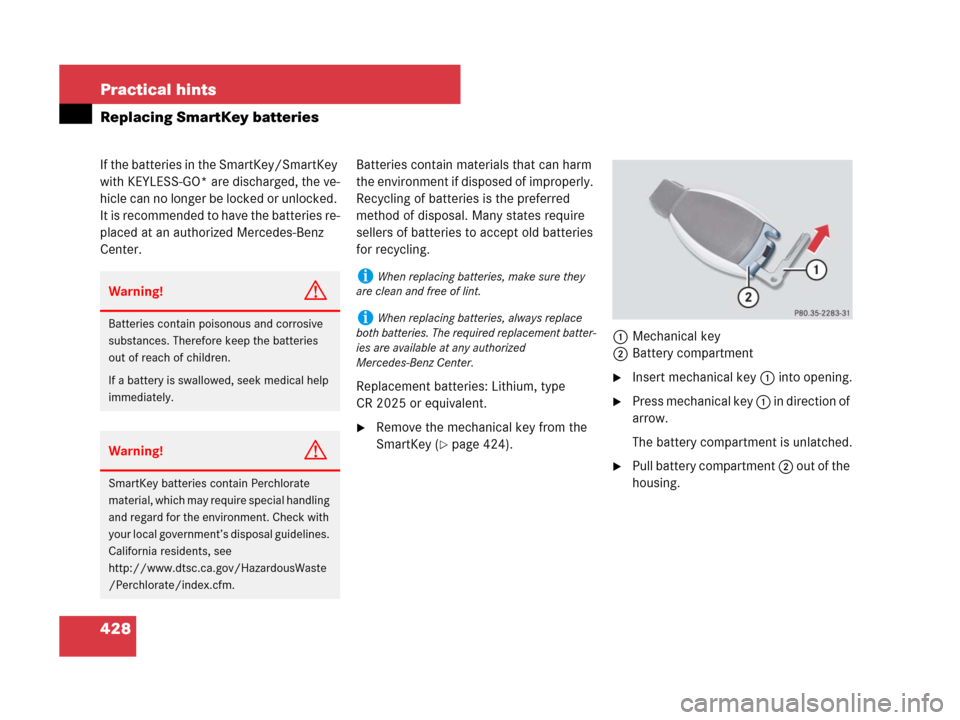
428 Practical hints
Replacing SmartKey batteries
If the batteries in the SmartKey/SmartKey
with KEYLESS-GO* are discharged, the ve-
hicle can no longer be locked or unlocked.
It is recommended to have the batteries re-
placed at an authorized Mercedes-Benz
Center.Batteries contain materials that can harm
the environment if disposed of improperly.
Recycling of batteries is the preferred
method of disposal. Many states require
sellers of batteries to accept old batteries
for recycling.
Replacement batteries: Lithium, type
CR 2025 or equivalent.
�Remove the mechanical key from the
SmartKey (
�page 424).1Mechanical key
2Battery compartment
�Insert mechanical key 1 into opening.
�Press mechanical key 1 in direction of
arrow.
The battery compartment is unlatched.
�Pull battery compartment 2 out of the
housing.
Warning!G
Batteries contain poisonous and corrosive
substances. Therefore keep the batteries
out of reach of children.
If a battery is swallowed, seek medical help
immediately.
Warning!G
SmartKey batteries contain Perchlorate
material, which may require special handling
and regard for the environment. Check with
your local government’s disposal guidelines.
California residents, see
http://www.dtsc.ca.gov/HazardousWaste
/Perchlorate/index.cfm.
iWhen replacing batteries, make sure they
are clean and free of lint.
iWhen replacing batteries, always replace
both batteries. The required replacement batter-
ies are available at any authorized
Mercedes-Benz Center.
Page 430 of 509
429 Practical hints
Replacing SmartKey batteries
3Batteries
4Contact springs
�Pull out batteries3.
�Using a line-free cloth, insert new bat-
teries 3 under contact springs 4 with
the positive terminal (+) side facing up.
�Return battery compartment 2 into
housing until it locks into place.
�Slide the mechanical key back into the
SmartKey.
�Check the operation of the SmartKey
or SmartKey with KEYLESS-GO*.